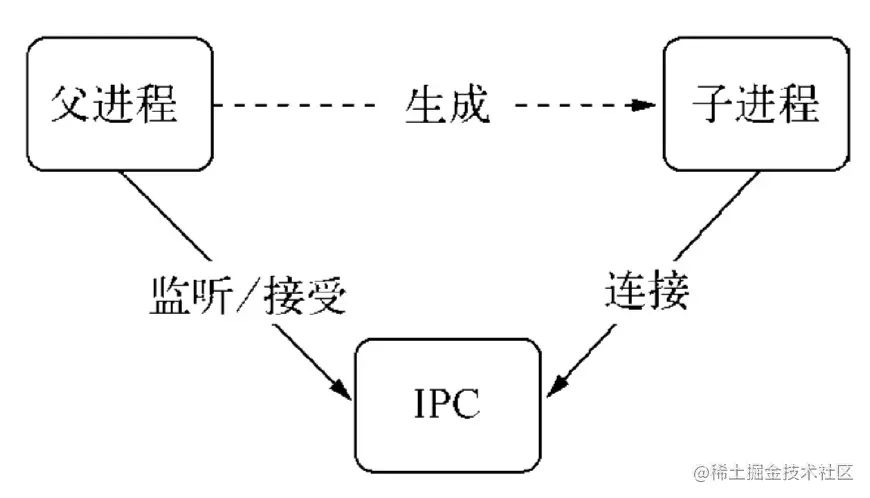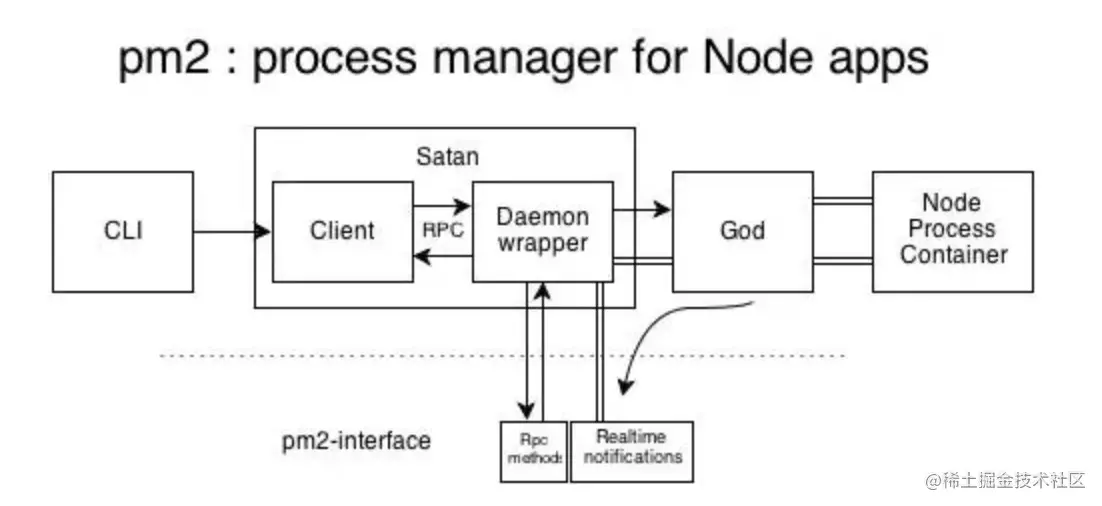Teach you step by step how to use clusters in Node
This article will take you to learn more about the cluster in Node.js and introduce the cluster event. I hope it will be helpful to everyone!

1. Introduction
Node In v0.8, the cluster module was directly introduced to It solves the problem of multi-core CPU utilization and also provides a relatively complete API to deal with the robustness of the process.
cluster module calls the fork method to create a child process, which is the same method as fork in child_process. The cluster module uses the classic master-slave model. The cluster will create a master and then copy multiple child processes according to the number you specify. You can use the cluster.isMaster property to determine whether the current process is a master or a worker (worker process). The master process manages all sub-processes. The master process is not responsible for specific task processing. Its main job is to be responsible for scheduling and management.
The cluster module uses built-in load balancing to better handle the pressure between threads, which uses the Round-robin algorithm (also known as the round-robin algorithm). When using the Round-robin scheduling strategy, the master accepts() all incoming connection requests and then sends the corresponding TCP request processing to the selected worker process (this method still communicates through IPC). The official usage example is as follows
const cluster = require('cluster');
const cpuNums = require('os').cpus().length;
const http = require('http');
if (cluster.isMaster) {
for (let i = 0; i < cpuNums; i++){
cluster.fork();
}
// 子进程退出监听
cluster.on('exit', (worker,code,signal) => {
console.log('worker process died,id',worker.process.pid)
})
} else {
// 给子进程标注进程名
process.title = `cluster 子进程 ${process.pid}`;
// Worker可以共享同一个 TCP 连接,这里是一个 http 服务器
http.createServer((req, res)=> {
res.end(`response from worker ${process.pid}`);
}).listen(3000);
console.log(`Worker ${process.pid} started`);
}In fact, the cluster module is applied by a combination of child_process and net modules. When the cluster starts, it will start the TCP server internally. When the cluster.fork() child process, this TCP The file descriptor of the server-side socket is sent to the worker process. If the worker process is copied through cluster.fork(), then NODE_UNIQUE_ID exists in its environment variable. If there is a listen() call to listen to the network port in the worker process, it will get the file descriptor through the SO_REUSEADDR port. Reuse, thereby enabling multiple child processes to share the port.
2. Cluster event
fork: This event is triggered after copying a worker process;
online: After copying a working process, the working process actively sends an online message to the main process. After the main process receives the message, the event is triggered;
listening: called in the working process After listen() (the server-side Socket is shared), a listening message is sent to the main process. After the main process receives the message, the event is triggered;
disconnect: main process and worker process This event will be triggered when the IPC channel is disconnected;
exit: This event will be triggered when a worker process exits;
setup: This event is triggered after cluster.setupMaster() is executed;
Most of these events are related to the events of the child_process module, and are encapsulated based on inter-process message passing.
cluster.on('fork', ()=> {
console.log('fork 事件... ');
})
cluster.on('online', ()=> {
console.log('online 事件... ');
})
cluster.on('listening', ()=> {
console.log('listening 事件... ');
})
cluster.on('disconnect', ()=> {
console.log('disconnect 事件... ');
})
cluster.on('exit', ()=> {
console.log('exit 事件... ');
})
cluster.on('setup', ()=> {
console.log('setup 事件... ');
})3. Communication between master and worker
As can be seen from the above, the master process creates worker processes through cluster.fork(). In fact, cluster.fork() internal Child processes are created through child_process.fork(). That is to say: the master and worker processes are parent and child processes; they communicate through the IPC channel just like the parent-child processes created by child_process.
The full name of IPC is Inter-Process Communication, which is inter-process communication. The purpose of inter-process communication is to allow different processes to access resources and coordinate work with each other. The IPC channel in Node is implemented by pipe technology. The specific implementation is provided by libuv. It is implemented by named pipe under Windows. *nix system uses Unix Domain Socket. The inter-process communication implemented on the application layer only has a simple message event and send method, which is very simple to use.

The parent process will create an IPC channel and listen to it before actually creating the child process, and then actually create the child process and tell the child process through the environment variable (NODE_CHANNEL_FD) The file descriptor for this IPC channel. During the startup process, the child process connects to the existing IPC channel according to the file descriptor, thereby completing the connection between the parent and child processes.

After the connection is established, the parent and child processes can communicate freely. Because IPC channels are created using Named Pipes or Domain Sockets, they behave similarly to network sockets and are two-way communications. The difference is that they complete inter-process communication in the system kernel without going through the actual network layer, which is very efficient. In Node, the IPC channel is abstracted as a Stream object. When send is called, data is sent (similar to write ), and the received message is triggered to the application layer through the message event (similar to data ).
master 和 worker 进程在 server 实例的创建过程中,是通过 IPC 通道进行通信的,那会不会对我们的开发造成干扰呢?比如,收到一堆其实并不需要关心的消息?答案肯定是不会?那么是怎么做到的呢?
Node 引入进程间发送句柄的功能,send 方法除了能通过 IPC 发送数据外,还能发送句柄,第二个参数为句柄,如下所示
child.send(meeage, [sendHandle])
句柄是一种可以用来标识资源的引用,它的内部包含了指向对象的文件描述符。例如句柄可以用来标识一个服务器端 socket 对象、一个客户端 socket 对象、一个 UDP 套接字、一个管道等。 那么句柄发送跟我们直接将服务器对象发送给子进程有没有什么差别?它是否真的将服务器对象发送给子进程?
其实 send() 方法在将消息发送到 IPC 管道前,将消息组装成两个对象,一个参数是 handle,另一个是 message,message 参数如下所示
{
cmd: 'NODE_HANDLE',
type: 'net.Server',
msg: message
}发送到 IPC 管道中的实际上是要发送的句柄文件描述符,其为一个整数值。这个 message 对象在写入到 IPC 管道时会通过 JSON.stringify 进行序列化,转化为字符串。子进程通过连接 IPC 通道读取父进程发送来的消息,将字符串通过 JSON.parse 解析还原为对象后,才触发 message 事件将消息体传递给应用层使用。在这个过程中,消息对象还要被进行过滤处理,message.cmd 的值如果以 NODE_ 为前缀,它将响应一个内部事件 internalMessage ,如果 message.cmd 值为 NODE_HANDLE,它将取出 message.type 值和得到的文件描述符一起还原出一个对应的对象。这个过程的示意图如下所示

在 cluster 中,以 worker 进程通知 master 进程创建 server 实例为例子。worker 伪代码如下:
// woker进程
const message = {
cmd: 'NODE_CLUSTER',
type: 'net.Server',
msg: message
};
process.send(message);master 伪代码如下:
worker.process.on('internalMessage', fn);
四、如何实现端口共享
在前面的例子中,多个 woker 中创建的 server 监听了同个端口 3000,通常来说,多个进程监听同个端口,系统会报 EADDRINUSE 异常。为什么 cluster 没问题呢?
因为独立启动的进程中,TCP 服务器端 socket 套接字的文件描述符并不相同,导致监听到相同的端口时会抛出异常。但对于 send() 发送的句柄还原出来的服务而言,它们的文件描述符是相同的,所以监听相同端口不会引起异常。
这里需要注意的是,多个应用监听相同端口时,文件描述符同一时间只能被某个进程所用,换言之就是网络请求向服务器端发送时,只有一个幸运的进程能够抢到连接,也就是说只有它能为这个请求进行服务,这些进程服务是抢占式的。
五、如何将请求分发到多个worker
- 每当 worker 进程创建 server 实例来监听请求,都会通过 IPC 通道,在 master 上进行注册。当客户端请求到达,master 会负责将请求转发给对应的 worker;
- 具体转发给哪个 worker?这是由转发策略决定的,可以通过环境变量 NODE_CLUSTER_SCHED_POLICY 设置,也可以在 cluster.setupMaster(options) 时传入,默认的转发策略是轮询(SCHED_RR);
- 当有客户请求到达,master 会轮询一遍 worker 列表,找到第一个空闲的 worker,然后将该请求转发给该worker;
六、pm2 工作原理
pm2 是 node 进程管理工具,可以利用它来简化很多 node 应用管理的繁琐任务,如性能监控、自动重启、负载均衡等。
pm2 自身是基于 cluster 模块进行封装的, 本节我们主要 pm2 的 Satan 进程、God Daemon 守护进程 以及两者之间的进程间远程调用 RPC。
撒旦(Satan),主要指《圣经》中的堕天使(也称堕天使撒旦),被看作与上帝的力量相对的邪恶、黑暗之源,是God 的对立面。

其中 Satan.js 提供程序的退出、杀死等方法,God.js 负责维持进程的正常运行,God 进程启动后一直运行,相当于 cluster 中的 Master进程,维持 worker 进程的正常运行。
RPC(Remote Procedure Call Protocol)是指远程过程调用,也就是说两台服务器A,B,一个应用部署在A 服务器上,想要调用 B 服务器上应用提供的函数/方法,由于不在一个内存空间,不能直接调用,需要通过网络来表达调用的语义和传达调用的数据。同一机器不同进程间的方法调用也属于 rpc 的作用范畴。 执行流程如下所示
每次命令行的输入都会执行一次 satan 程序,如果 God 进程不在运行,首先需要启动 God 进程。然后根据指令,Satan 通过 rpc 调用 God 中对应的方法执行相应的逻辑。
以 pm2 start app.js -i 4 为例,God 在初次执行时会配置 cluster,同时监听 cluster 中的事件:
// 配置cluster
cluster.setupMaster({
exec : path.resolve(path.dirname(module.filename), 'ProcessContainer.js')
});
// 监听cluster事件
(function initEngine() {
cluster.on('online', function(clu) {
// worker进程在执行
God.clusters_db[clu.pm_id].status = 'online';
});
// 命令行中 kill pid 会触发exit事件,process.kill不会触发exit
cluster.on('exit', function(clu, code, signal) {
// 重启进程 如果重启次数过于频繁直接标注为stopped
God.clusters_db[clu.pm_id].status = 'starting';
// 逻辑
// ...
});
})();在 God 启动后, 会建立 Satan 和 God 的rpc链接,然后调用 prepare 方法,prepare 方法会调用 cluster.fork 来完成集群的启动
God.prepare = function(opts, cb) {
// ...
return execute(opts, cb);
};
function execute(env, cb) {
// ...
var clu = cluster.fork(env);
// ...
God.clusters_db[id] = clu;
clu.once('online', function() {
God.clusters_db[id].status = 'online';
if (cb) return cb(null, clu);
return true;
});
return clu;
}七、总结
本文从 cluster 的基本使用、事件,到 cluster 的基本实现原理,再到 pm2 如何基于 cluster 进行进程管理,带你从入门到深入原理以及了解其高阶应用,希望对你有帮助。
更多node相关知识,请访问:nodejs 教程!!
The above is the detailed content of Teach you step by step how to use clusters in Node. For more information, please follow other related articles on the PHP Chinese website!

Hot AI Tools

Undresser.AI Undress
AI-powered app for creating realistic nude photos

AI Clothes Remover
Online AI tool for removing clothes from photos.

Undress AI Tool
Undress images for free

Clothoff.io
AI clothes remover

AI Hentai Generator
Generate AI Hentai for free.

Hot Article

Hot Tools

Notepad++7.3.1
Easy-to-use and free code editor

SublimeText3 Chinese version
Chinese version, very easy to use

Zend Studio 13.0.1
Powerful PHP integrated development environment

Dreamweaver CS6
Visual web development tools

SublimeText3 Mac version
God-level code editing software (SublimeText3)

Hot Topics
 How to delete node in nvm
Dec 29, 2022 am 10:07 AM
How to delete node in nvm
Dec 29, 2022 am 10:07 AM
How to delete node with nvm: 1. Download "nvm-setup.zip" and install it on the C drive; 2. Configure environment variables and check the version number through the "nvm -v" command; 3. Use the "nvm install" command Install node; 4. Delete the installed node through the "nvm uninstall" command.
 How to use express to handle file upload in node project
Mar 28, 2023 pm 07:28 PM
How to use express to handle file upload in node project
Mar 28, 2023 pm 07:28 PM
How to handle file upload? The following article will introduce to you how to use express to handle file uploads in the node project. I hope it will be helpful to you!
 An in-depth analysis of Node's process management tool 'pm2”
Apr 03, 2023 pm 06:02 PM
An in-depth analysis of Node's process management tool 'pm2”
Apr 03, 2023 pm 06:02 PM
This article will share with you Node's process management tool "pm2", and talk about why pm2 is needed, how to install and use pm2, I hope it will be helpful to everyone!
 Pi Node Teaching: What is a Pi Node? How to install and set up Pi Node?
Mar 05, 2025 pm 05:57 PM
Pi Node Teaching: What is a Pi Node? How to install and set up Pi Node?
Mar 05, 2025 pm 05:57 PM
Detailed explanation and installation guide for PiNetwork nodes This article will introduce the PiNetwork ecosystem in detail - Pi nodes, a key role in the PiNetwork ecosystem, and provide complete steps for installation and configuration. After the launch of the PiNetwork blockchain test network, Pi nodes have become an important part of many pioneers actively participating in the testing, preparing for the upcoming main network release. If you don’t know PiNetwork yet, please refer to what is Picoin? What is the price for listing? Pi usage, mining and security analysis. What is PiNetwork? The PiNetwork project started in 2019 and owns its exclusive cryptocurrency Pi Coin. The project aims to create a one that everyone can participate
 Let's talk about how to use pkg to package Node.js projects into executable files.
Dec 02, 2022 pm 09:06 PM
Let's talk about how to use pkg to package Node.js projects into executable files.
Dec 02, 2022 pm 09:06 PM
How to package nodejs executable file with pkg? The following article will introduce to you how to use pkg to package a Node project into an executable file. I hope it will be helpful to you!
 Node completely evacuates from Proxmox VE and rejoins the cluster
Feb 21, 2024 pm 12:40 PM
Node completely evacuates from Proxmox VE and rejoins the cluster
Feb 21, 2024 pm 12:40 PM
Scenario description for nodes to completely evacuate from ProxmoxVE and rejoin the cluster. When a node in the ProxmoxVE cluster is damaged and cannot be repaired quickly, the faulty node needs to be kicked out of the cluster cleanly and the residual information must be cleaned up. Otherwise, new nodes using the IP address used by the faulty node will not be able to join the cluster normally; similarly, after the faulty node that has separated from the cluster is repaired, although it has nothing to do with the cluster, it will not be able to access the web management of this single node. In the background, information about other nodes in the original ProxmoxVE cluster will appear, which is very annoying. Evict nodes from the cluster. If ProxmoxVE is a Ceph hyper-converged cluster, you need to log in to any node in the cluster (except the node you want to delete) on the host system Debian, and run the command
 Token-based authentication with Angular and Node
Sep 01, 2023 pm 02:01 PM
Token-based authentication with Angular and Node
Sep 01, 2023 pm 02:01 PM
Authentication is one of the most important parts of any web application. This tutorial discusses token-based authentication systems and how they differ from traditional login systems. By the end of this tutorial, you will see a fully working demo written in Angular and Node.js. Traditional Authentication Systems Before moving on to token-based authentication systems, let’s take a look at traditional authentication systems. The user provides their username and password in the login form and clicks Login. After making the request, authenticate the user on the backend by querying the database. If the request is valid, a session is created using the user information obtained from the database, and the session information is returned in the response header so that the session ID is stored in the browser. Provides access to applications subject to
 How to configure and install node.js in IDEA? Brief analysis of methods
Dec 21, 2022 pm 08:28 PM
How to configure and install node.js in IDEA? Brief analysis of methods
Dec 21, 2022 pm 08:28 PM
How to run node in IDEA? The following article will introduce to you how to configure, install and run node.js in IDEA. I hope it will be helpful to you!







